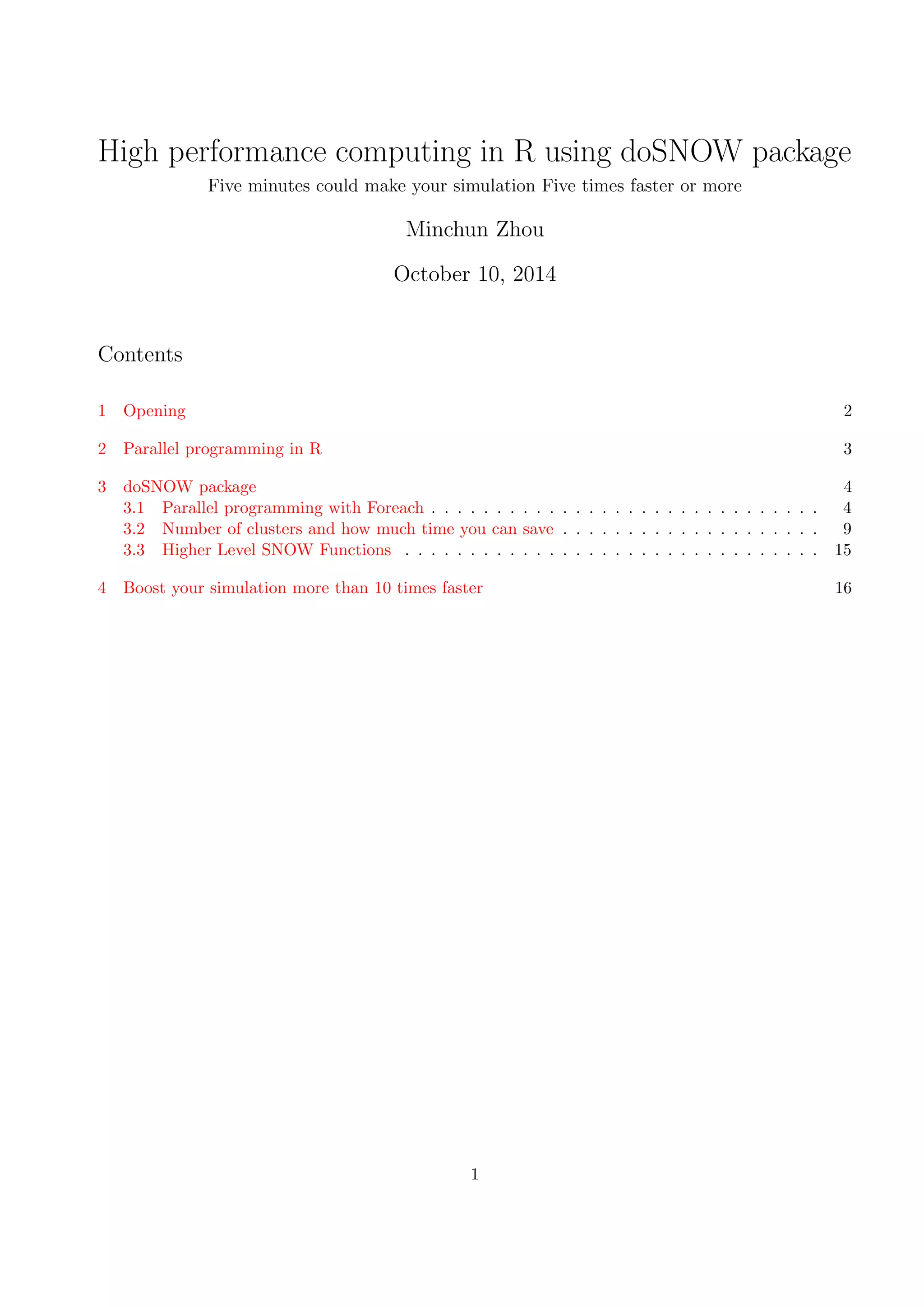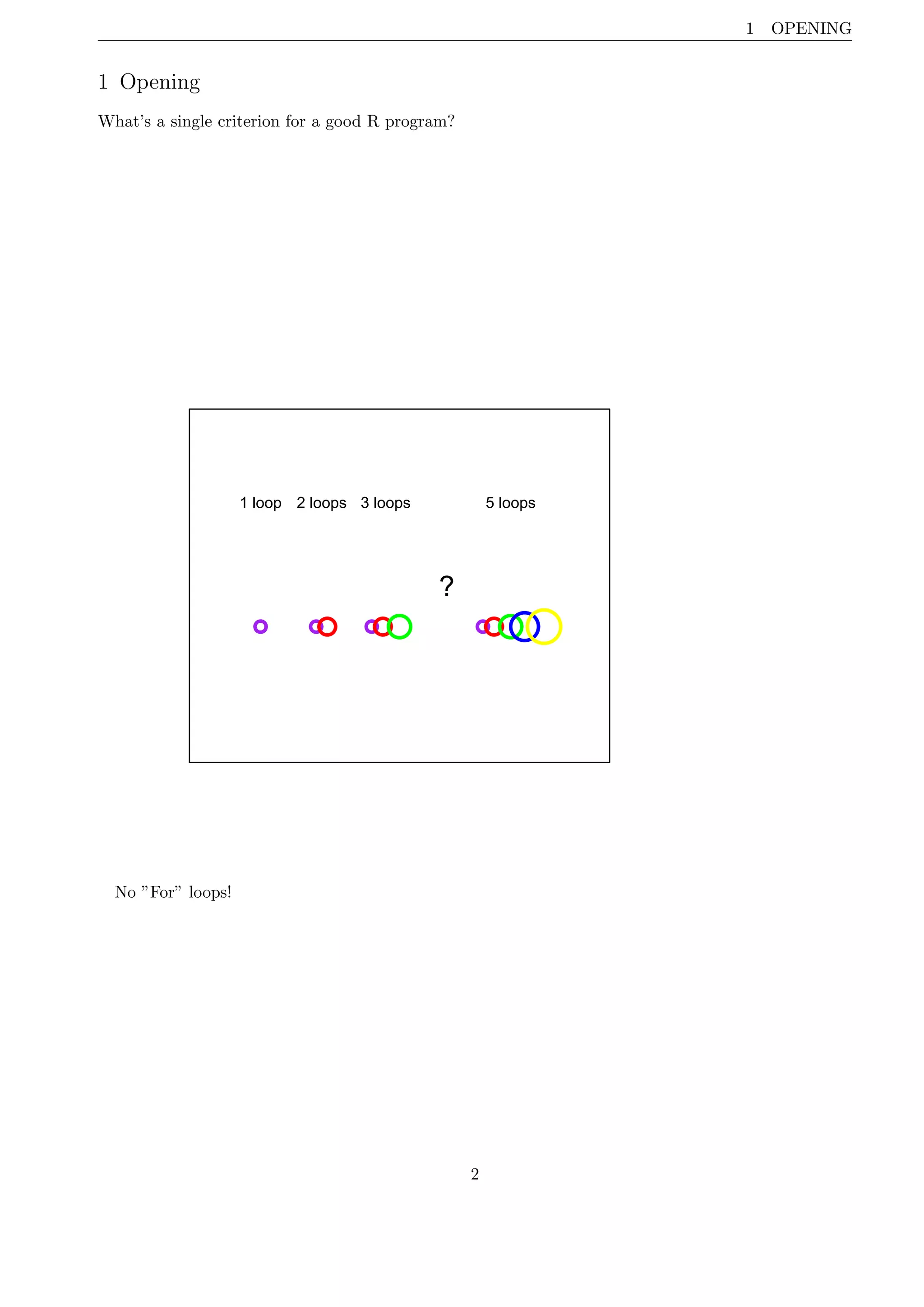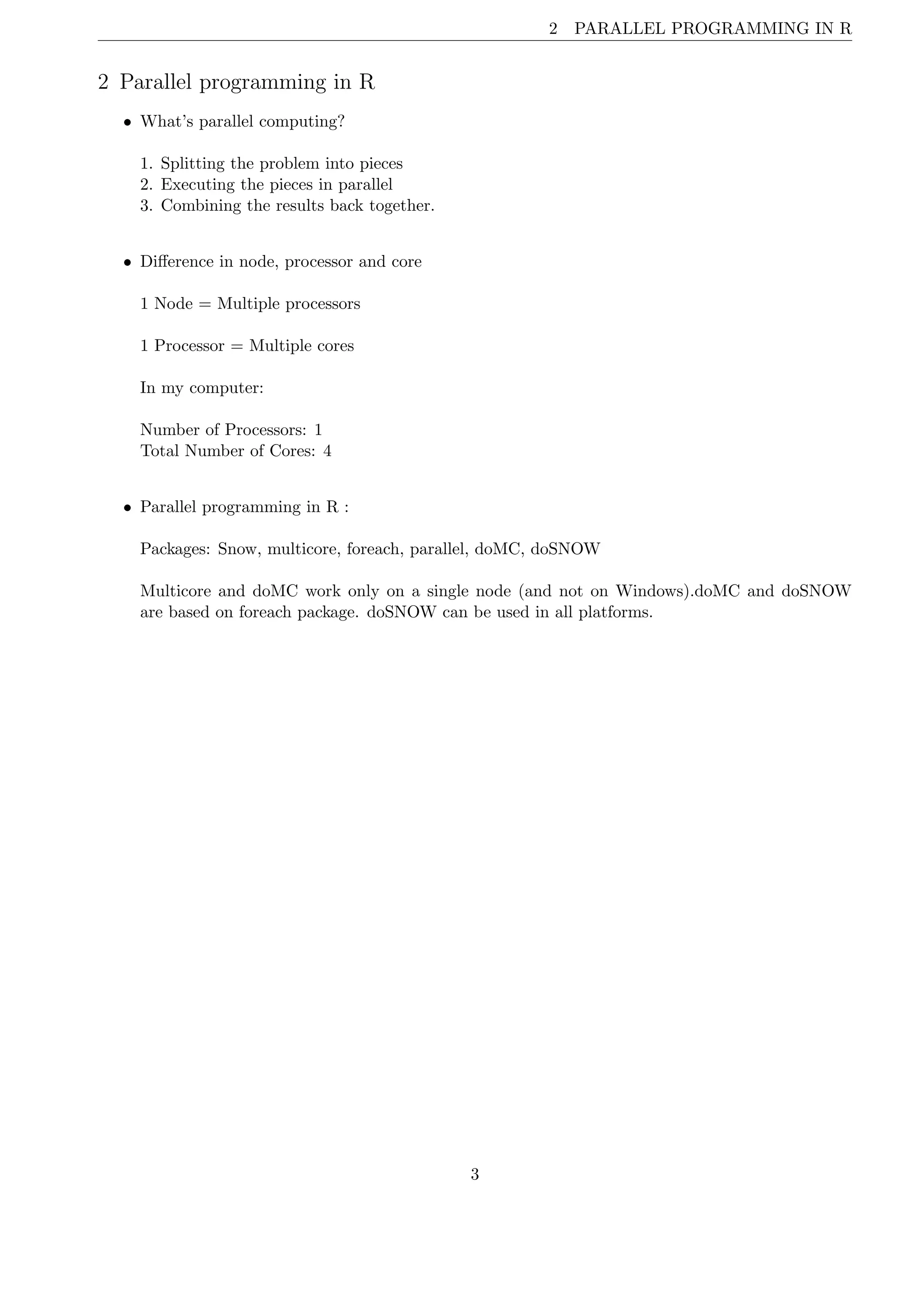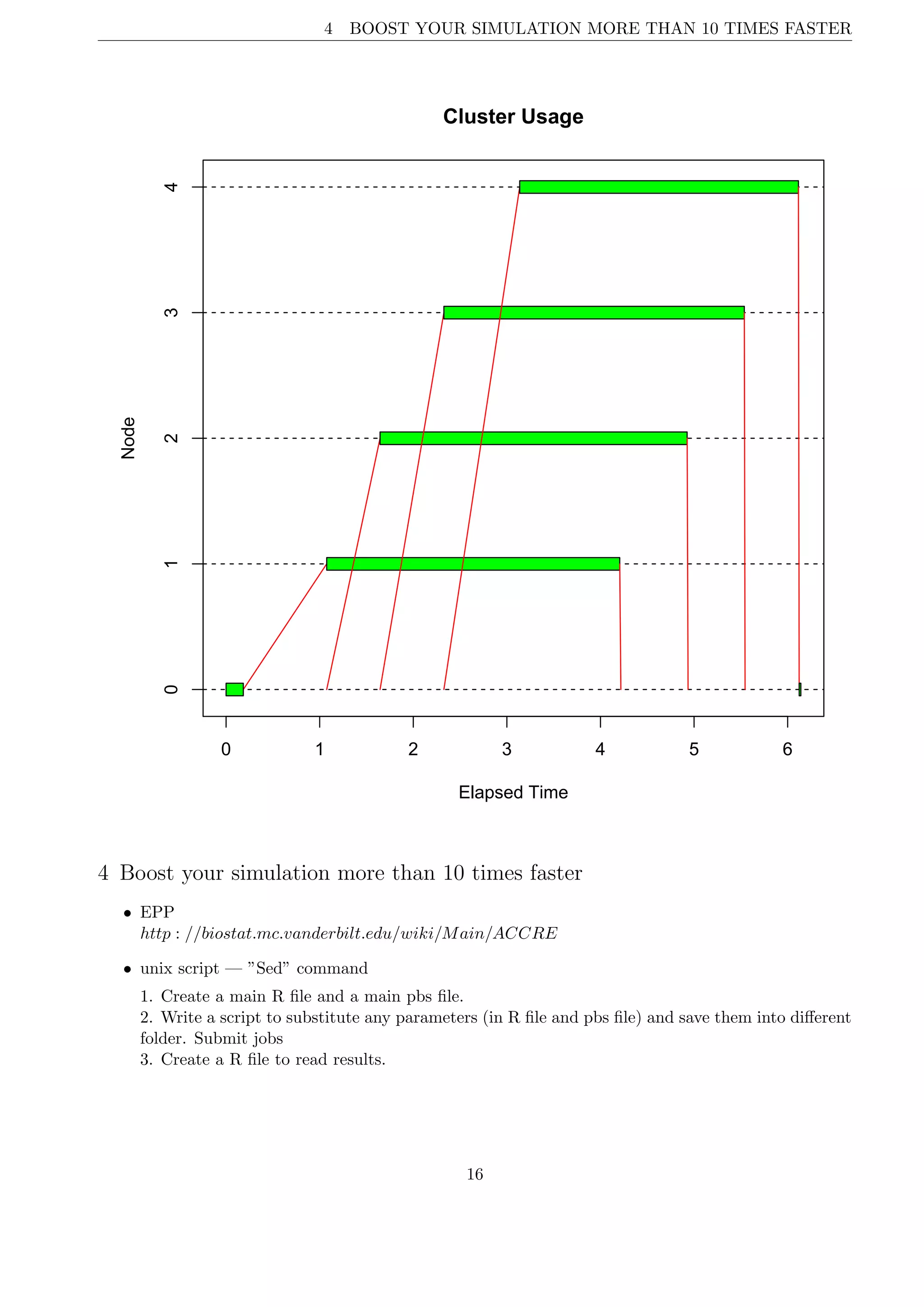This document discusses using the doSNOW package in R to perform parallel programming and speed up simulations. It explains how to register clusters, use foreach loops with .combine functions, and load necessary packages within loops. Testing with different numbers of clusters shows speedups over serial execution, with optimal speedups achieved when the number of clusters matches or exceeds the number of cores. Processing jobs in parallel reduces the elapsed time for each job.



![3 DOSNOW PACKAGE
3 doSNOW package
3.1 Parallel programming with Foreach
• Number of cores in your computer
library(parallel)
detectCores()
## [1] 8
# This number devided by 2 is the number of cores in your computer
• Register clusters
library(doSNOW)
## Loading required package: foreach
## Loading required package: iterators
## Loading required package: snow
##
## Attaching package: ’snow’
##
## The following objects are masked from ’package:parallel’:
##
## clusterApply, clusterApplyLB, clusterCall, clusterEvalQ,
## clusterExport, clusterMap, clusterSplit, makeCluster,
## parApply, parCapply, parLapply, parRapply, parSapply,
## splitIndices, stopCluster
NumberOfCluster <- 4
# how many jobs you want the computer to run at the same time
cl <- makeCluster(NumberOfCluster) # Make clusters
registerDoSNOW(cl) # use the above cluster
# your parallel programming code code code
stopCluster(cl) # close clusters
4](https://image.slidesharecdn.com/dosnow-160929062620/75/Do-snow-rwn-4-2048.jpg)
![3.1 Parallel programming with Foreach 3 DOSNOW PACKAGE
• Review: For loop syntax
for (i in vector){
code
return(object)
}
• Foreach loop syntax
foreach (i=vector, .combine=’fun’) %dopar% {
code
return(object)
}
By default, the results are returned in a list.
.combine = ’fun’
fun = c : vector
fun = cbind: column bind
fun = rbind: row bind
fun = + : sum data
fun = * : multiple data
fun can be any function that you define.
x <- matrix(NA, ncol = 5, nrow = 5)
for (i in 1:5) {
x[i, ] <- (1:5)^i
}
x
## [,1] [,2] [,3] [,4] [,5]
## [1,] 1 2 3 4 5
## [2,] 1 4 9 16 25
## [3,] 1 8 27 64 125
## [4,] 1 16 81 256 625
## [5,] 1 32 243 1024 3125
library(doSNOW)
NumberOfCluster <- 4
cl <- makeCluster(NumberOfCluster)
registerDoSNOW(cl)
x0 <- foreach(i = 1:5) %dopar% {
y <- (1:5)^i
return(y)
}
class(x0)
## [1] "list"
5](https://image.slidesharecdn.com/dosnow-160929062620/75/Do-snow-rwn-5-2048.jpg)
![3.1 Parallel programming with Foreach 3 DOSNOW PACKAGE
x <- foreach(i = 1:5, .combine = "rbind") %dopar% {
y <- (1:5)^i
return(y)
}
stopCluster(cl)
x
## [,1] [,2] [,3] [,4] [,5]
## result.1 1 2 3 4 5
## result.2 1 4 9 16 25
## result.3 1 8 27 64 125
## result.4 1 16 81 256 625
## result.5 1 32 243 1024 3125
# which is equavilant to use .combine='fun' using the following function
fun <- function(...) {
rbind(...)
}
cl <- makeCluster(NumberOfCluster)
registerDoSNOW(cl)
x <- foreach(i = 1:5, .combine = "fun") %dopar% {
y <- (1:5)^i
return(y)
}
stopCluster(cl)
x
## [,1] [,2] [,3] [,4] [,5]
## result.1 1 2 3 4 5
## result.2 1 4 9 16 25
## result.3 1 8 27 64 125
## result.4 1 16 81 256 625
## result.5 1 32 243 1024 3125
fun <- function(...) {
rbind(...) + 1
}
cl <- makeCluster(NumberOfCluster)
registerDoSNOW(cl)
x1 <- foreach(i = 1:5, .combine = "fun") %dopar% {
y <- (1:5)^i
return(y)
}
stopCluster(cl)
6](https://image.slidesharecdn.com/dosnow-160929062620/75/Do-snow-rwn-6-2048.jpg)
![3.1 Parallel programming with Foreach 3 DOSNOW PACKAGE
x1
## [,1] [,2] [,3] [,4] [,5]
## result.1 5 6 7 8 9
## result.2 5 8 13 20 29
## result.3 4 11 30 67 128
## result.4 3 18 83 258 627
## result.5 2 33 244 1025 3126
x
## [,1] [,2] [,3] [,4] [,5]
## result.1 1 2 3 4 5
## result.2 1 4 9 16 25
## result.3 1 8 27 64 125
## result.4 1 16 81 256 625
## result.5 1 32 243 1024 3125
# be careful to use your own function, you need to take care of all results
• When use foreach function, you need to put library(package) within the loop. It’s like you open
multiple new R windows. Or you can use .packages option.
library(rms)
NumberOfCluster <- 4
cl <- makeCluster(NumberOfCluster)
registerDoSNOW(cl)
x0 <- foreach(i = 1:4, .combine = "rbind") %dopar% {
y <- coef(ols(rnorm(10) ~ rnorm(10)))
return(y)
}
## Error: task 1 failed - "could not find function "ols""
x1 <- foreach(i = 1:4, .combine = "rbind", .packages = "rms") %dopar% {
y <- coef(ols(rnorm(10) ~ rnorm(10)))
return(y)
}
x2 <- foreach(i = 1:4, .combine = "rbind") %dopar% {
library(rms)
y <- coef(ols(rnorm(10) ~ rnorm(10)))
return(y)
}
stopCluster(cl)
cbind(x1, x2)
## Intercept Intercept
7](https://image.slidesharecdn.com/dosnow-160929062620/75/Do-snow-rwn-7-2048.jpg)
![3.1 Parallel programming with Foreach 3 DOSNOW PACKAGE
## result.1 -0.40349 0.05660
## result.2 -0.13257 0.41074
## result.3 0.05878 -0.01726
## result.4 0.33880 0.39169
• You don’t need to load data in each loop.
data <- data.frame(x1 = rnorm(10), x2 = rnorm(10), x3 = rnorm(10))
NumberOfCluster <- 4
cl <- makeCluster(NumberOfCluster)
registerDoSNOW(cl)
x <- foreach(i = 1:10, .combine = "c") %dopar% {
y <- sum(data[i, ])
return(y)
}
stopCluster(cl)
y
## Error: object ’y’ not found
• There is no interaction between loops. Forexample, you can not use the result from jth loop in
j + 1th loop.
x <- 0
for (i in 1:10) {
y <- x[i] + i^i
x <- c(x, y)
}
x
## [1] 0.000e+00 1.000e+00 5.000e+00 3.200e+01 2.880e+02 3.413e+03 5.007e+04
## [8] 8.736e+05 1.765e+07 4.051e+08 1.041e+10
x <- 0
cl <- makeCluster(5)
registerDoSNOW(cl)
x <- foreach(i = 1:10) %dopar% {
y <- x[i] + i^i
x <- c(x, y)
return(x)
}
stopCluster(cl)
x
## [[1]]
## [1] 0 1
##
8](https://image.slidesharecdn.com/dosnow-160929062620/75/Do-snow-rwn-8-2048.jpg)
![3.2 Number of clusters and how much time you can save 3 DOSNOW PACKAGE
## [[2]]
## [1] 0 NA
##
## [[3]]
## [1] 0 NA
##
## [[4]]
## [1] 0 NA
##
## [[5]]
## [1] 0 NA
##
## [[6]]
## [1] 0 1 NA
##
## [[7]]
## [1] 0 NA NA
##
## [[8]]
## [1] 0 1 NA NA
##
## [[9]]
## [1] 0 NA NA
##
## [[10]]
## [1] 0 NA NA NA
3.2 Number of clusters and how much time you can save
rrt.all = c(12, 12.5, 13.5, 16)
rrd = 15
tms.all = c(c(7, 8, 9, 10, 44, 45, 46)/60, c(27, 28, 29, 30)/60 + 12, 16)
rrt = rrt.all
tms = tms.all
loops = 32
err = 0.025
cv = 0.25
n <- 1
source("/Users/Michaelzmc/Documents/simuresult/snowtest/bigsimu/0608simu/design.R")
# one simulation
t0 <- system.time({
set.seed(n)
pk_simulate(tms = tms, rrt = rrt, rrd = rrd, err = err, cv = cv)
9](https://image.slidesharecdn.com/dosnow-160929062620/75/Do-snow-rwn-9-2048.jpg)



![3.2 Number of clusters and how much time you can save 3 DOSNOW PACKAGE
0 20 40 60 80 100 120
Elapsed Time
Node
024681013161922252831
Cluster Usage
time.eachjob <- function(n, t.snow) {
mean(sapply(1:n, function(x) mean(t.snow$data[[x]][, 5]), simplify = "array"))
}
time.eachjob(2, t.snow.2)
## [1] 13.09
time.eachjob(4, t.snow.4)
## [1] 18.14
time.eachjob(16, t.snow.16)
13](https://image.slidesharecdn.com/dosnow-160929062620/75/Do-snow-rwn-13-2048.jpg)
![3.2 Number of clusters and how much time you can save 3 DOSNOW PACKAGE
## [1] 44.41
time.eachjob(32, t.snow.32)
## [1] 66.63
Another example:
library(gdata)
library(XML)
library(RCurl)
library(doSNOW)
# clean the data in the xls file
clean <- function(data) {
d <- data[, c(2, 3, 5, 6, 7)]
colnames(d) <- c("use", "address", "city", "date", "price")
p <- sub("$", "", d$price)
p <- sub(",", "", p)
d$price <- as.numeric(p)
d <- subset(d, use %in% c("SINGLE FAMILY", "RESIDENTIAL CONDO") & price <=
3e+05 & price >= 150000)
d$address1 <- paste0(d$address, " ", d$city)
# d£distance <- sapply(d£address, function(x) latlon2ft(origin=gsub(' ',
# '_', x), destination='Nashville') , simplify='array')
return(d)
}
m13 <- rep(c("jan", "feb", "mar", "04", "05", "06", "07", "08", "09", "10",
"11", "12"), 8)
t1 <- system.time({
x <- NULL
for (i in m13) {
x <- rbind(x, clean(read.xls(paste0("http://www.padctn.com/forms/2013/",
i, "_z_1.xls"))))
}
})
# start reading data
cl <- makeCluster(8)
registerDoSNOW(cl)
t2 <- system.time({
z1.13 <- foreach(i = m13, .combine = "rbind") %dopar% {
library(gdata)
library(XML)
library(RCurl)
x <- read.xls(paste0("http://www.padctn.com/forms/2013/", i, "_z_1.xls"))
return(clean(x))
}
14](https://image.slidesharecdn.com/dosnow-160929062620/75/Do-snow-rwn-14-2048.jpg)

